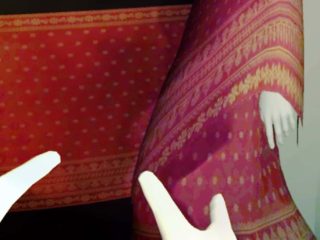By adding materiality to present-day digital photo touchup applications and bringing them into the physical, Skin Lab makes users, especially the Indian diaspora, confront colorism prevalent in contemporary India through its manifestation in a physical form. It intends to bring to the forefront a historically rooted prejudice within the Indian community, that might have been one of the unseen ramifications of the advent of western civilisation in India.
The focus of concept development was to bring a pressing underlying prejudice to the foreground.
Applying the lens of Critical Design to present-day digital photo touch-up and augmented makeup applications, an interface that allowed to pick a preferred skin tone was envisioned. The use of physical computing – a tactile interface and real-time projection of the user’s selection onto a physical object – introduced materiality and tangibility to a bias which otherwise exists at a subconscious level. The concept art helped illustrate this in the form of a physical installation. Next, the wireframe visualised the aesthetics of the interface and interactions with it. Different kinds of interactions such as single touch, multiple taps, and dial motion were explored to unearth the ones that might feel most intuitive.
Construction
The circuitry of the tactile interface went through a series of iterations, starting with a circular Fabric Potentiometer (Perner-Wilson and Satomi) that served as a dial for changing the skin tone incrementally from light to dark. This was a useful proof of concept, however, the readings were inconsistent due to the use of conductive thread. Next, the affordances of a Circular Ribbon-Sensor Soft Potentiometer (Spectra Symbol) versus a Wired Potentiometer Breakout Board (Stemma) were tested. The Wired Potentiometer was preferred as it gave a more consistent reading and the motion of turning the dial to affect the skin color was more impactful. A Solid Machined Metal Knob (Adafruit) was attached to the potentiometer to accentuate the functionality and appearance of this sensor.
The aesthetic of the tactile interface was inspired by iconographies from emerging digital photo-enhancing and augmented feature applications. Due to lack of access to fabrication studios in the pandemic, this interface was fabricated using resources available to me, including an acrylic sheet, colored plastic art papers and conductive fabric. The choice of minimalistic user interface on a sleek, transparent acrylic sheet helped lend a futuristic appeal to the tactile device.
Installation
The exploration of visual design of the output involved creating a pool of skin tones that allowed a range for users, starting from light to incrementally darker tones. A similar rationale was applied to create a pool of color options for eyes and lips. The tones were applied onto a 3D model of a head, which was assembled by morphing features from different male and female 3D models. A featureless, genderless mannequin of a head was used as the projection surface of the output.








